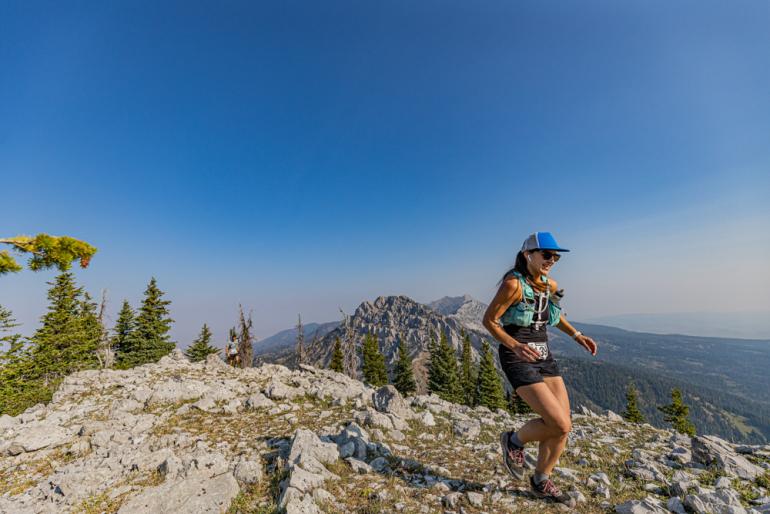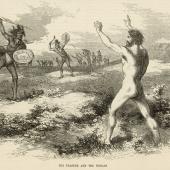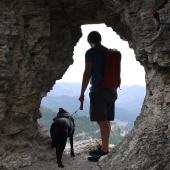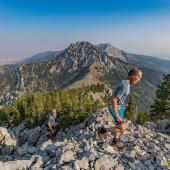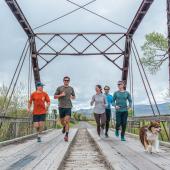Steep Learning Curve
When I mailed my first Jim Bridger Trail Run application in during the spring of 2003, I really did have the full intent of actually training for it. But I had no idea what I was getting into, as the “trail” part of the equation didn’t quite register. You see, I was a pavement junkie. If anyone had asked me what part of “trail” I didn’t understand, I’d have to say the whole thing.
I really hate early morning races, but as we wound our way up the dirt roads toward Sypes Canyon, I thought, how hard could this really be? The first couple of miles followed a country road paralleling the west side of the Bridgers. My partner and I had a fast start; we quickly left a good chunk of the crowd behind us. “Oh yeah,” I thought to myself, “This one’s going to be a piece of cake.” About 20 minutes later, we turned smack dab into the Bridgers and started climbing. The elevation change hit me like a ton of bricks. Gone were the wide-open dirt roads, rolling hills, and sunshine. Hello rock-lined goat track and hellish vertical grade with too few switchbacks and no room to pull over. The cacophony of heavy breathing and stampeding feet of the runners I’d so gleefully passed were now about to run up my backside. I thought I was going to pass out and die.
This was my baptism into trail running and the learning curve was steep. But I survived and eventually became hooked on the sport. It ain’t your skip-to-the-loo, take-off-out-your-backdoor, serendipitous kind of afternoon quickie—trail running is a whole breed apart.
Where the Rubber Meets the Dirt
Trail running can easily become an addiction. I find myself not thinking so much about the painful running aspect but rather the mellow aromatic and scenic bliss that’s delivered every single time—plus, as we age it’s a heck of a lot easier on our feet and knees (and hey, walking up the really steep parts is fine). Without thought and with any luck, you’ll find yourself running farther than you ever have before. You’ll soon enter races you once thought impossible, and may even have visions of running the ungodly Devil’s Backbone 50-miler. Many Bozemanites have most likely done some trail running thanks to the great in-town paths, but they really don’t get the full ride there. Try climbing to the top of our amazing peaks (consider Mount Blackmore) and poke out above treeline or bust your lungs on fierce ascents. Besides, variety is the spice of life, and the trails surrounding Bozeman provide that and more for trail runners. These trails include but are not limited to the Bridgers (west, north, east sections), Bangtails, Hyalite (lower, middle, upper), and Gallatin Canyon.
According to Tom Hayes, an avid trail runner and ultra-marathoner, “Bozeman is the place to be if you want to be a trail runner of any length, from ten miles to 100, and there’s a great ultra-marathoning community here.” If ultra-marathoning (think in terms of running days, not hours) seems a bit daunting to you, no worries—it all starts with putting one foot in front of the other: “relentless forward motion,” as Tom puts it. If you’re new to trail running or to Bozeman, you might want to consider hanging out with the Big Sky Wind Drinkers. They’ve set up two weekly trail running groups: one convenes on Wednesdays at 6 pm and the other meets every Saturday morning at 7:30. You’ll get more than a sample of what Bozeman trails have to offer, including Sypes Canyon, History Rock, Stone Creek, North and South Cottonwood, and even Mount Blackmore.
The organization accommodates all levels, all dogs, and all Bozeman trails. You can join them for the entire loop or do your own out-and-back. They start out with roughly six-mile runs and work up to a little over 20 miles, covering lots of terrain and providing incredible variety. You can download their running schedules from winddrinkers.org.
Ponder Before You Wander
There are a variety of circumstances and a few things you might want to consider and plan for in your trail-running endeavors: bears, snow, shoes (those skinny, rock-strewn, root-infested, singletrack trails call for a beefier piece of rubber), water (it’s heavy—consider a filter and camelback), food, fickle weather, and time (running one mile on a trail takes longer than one on pavement). And when out on the trail, pay particular attention to the things you have control over: your footing and your breathing. Last, a little tidbit I learned from experience: take it easy on the downhills. If you should injure yourself there is still only one way out.
You might want to invest in a trail guide. I use my mountain-biking guide because it provides detailed descriptions and directions on sometimes-confusing and ill-marked mountain trails. The Gallatin Valley Land Trust also has a nice overview of the in-town trails (gvlt.org/trails_maps.html), and there are a couple of local trail runners that have set up two great mountain-trail overviews at
math.montana.edu/~thayes/Runs/TrailsIntro and coe.montana.edu/ee/rmaher/pers/running. It’s always a great idea to get the scoop on a trail before you run it, and the Forest Service (522-2520) is a great source for current trail conditions. Brian McNeil, trail crew boss, and his charge are constantly out on the trails monitoring, clearing, and shoring them up. Brian urges trail users to stay on the trails, and when you come to a puddle, go through it—cutting switchbacks creates erosion and breaks down the trail structure. Also, respect others on the trail, go ahead and make a little noise around those blind corners, and tell the Forest Service what you like and dislike about the trails.
Going from Start to Finish
Trail running is rewarding all by itself, but there’s nothing like the rush of crossing a finish line. There are several great races around Bozeman every summer including the Jim Bridger Trail Run, the Old Gabe 25k or 50k, the Bridger Ridge Run, and the John Colter Run. You might even consider taking MSU professor Tom Hayes up on his “Explorer Series” challenge. The series is a side hobby of Tom’s that motivates trail runners to go out and do a few more races. You need to finish three out of five designated races (those noted above plus the Lewis & Clark half or full marathon). At the very least, check out the Montana race schedule located at runmt.com/r/cal1. So how do you take it to the next level? In a word: time. Get out on the trail and go for it.

